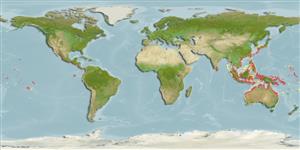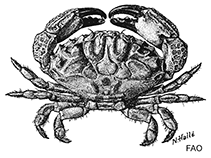Lophozozymus pictor (Fabricius, 1798)
Mosaic reef crab| Native range | All suitable habitat | Point map | Year 2050 |

|
| This map was computer-generated and has not yet been reviewed. |
| Lophozozymus pictor AquaMaps Data sources: GBIF OBIS |
Google image | No image available for this species;
drawing shows typical species in Xanthidae.
Classification / Names Common names | Synonyms | CoL | ITIS | WoRMS
Malacostraca | Decapoda | Xanthidae
Environment: milieu / climate zone / depth range / distribution range Ecology
Reef-associated; depth range 0 - 30 m (Ref. 96667). Tropical
Distribution Countries | FAO areas | Ecosystems | Occurrences | Introductions
Indo-Pacific.
Length at first maturity / Size / Weight / Age
Maturity: Lm ? range ? - ? cm Max length : 10.0 cm CW male/unsexed; (Ref. 128968); max. published weight: 100.00 g (Ref. 128968)
Short description Morphology
Life cycle and mating behavior Maturity | Reproduction | Spawning | Eggs | Fecundity | Larvae
Main reference
References | Coordinator | Collaborators
Yeo, D.C.J., T. Swee Hee and P.K.L. Ng 2008 Horseshoe crabs (Phylum Arthropoda: Subphylum Chelicerata: Class Merostomata) and Decapod crustaceans (Phylum Arthropoda: Subphylum Crustacea: Order Decapoda). In pp. 110-128, 259-262, Davison, G.W.H.; Ng, P.K.L.; Ho, H.C., 2008. The Singapore Red Data Book: Threatened plants and animals of Singapore. Singapore: The Nature Society, 285pp. (Ref. 85383)
IUCN Red List Status
(Ref. 130435: Version 2025-1)
CITES status (Ref. 108899)
CMS (Ref. 116361)
Threat to humans
Human uses
| FishSource |
Tools
More information
Diet composition
Food consumption
Predators
Max. ages / sizes
Length-weight rel.
Length-length rel.
Length-frequencies
Mass conversion
Abundance
Internet sources
BHL | BOLD Systems | CISTI | DiscoverLife | FAO(Publication : search) | Fishipedia | GenBank (genome, nucleotide) | GloBI | Gomexsi | Google Books | Google Scholar | Google | PubMed | Tree of Life | Wikipedia (Go, Search) | Zoological Record



